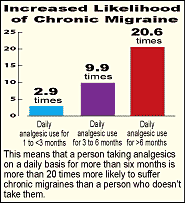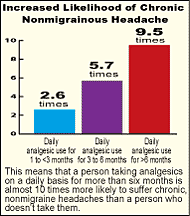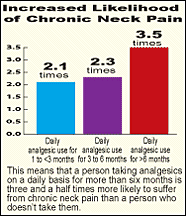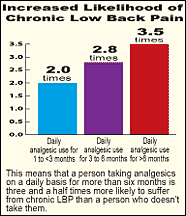Credit: Dynamic Chiropractic, Volume 31, Number 10, By Editorial Staff
http://www.dynamicchiropractic.com/mpacms/dc/article.php?id=46317
Analgesic Overuse Associated With Chronic Headaches, Neck and Back Pain
By Editorial Staff
The International Headache Society defines “medication overuse headache” (MOH) as “headache appearing at least 15 days/month; regular intake of analgesics or ergot alkaloids; and headache disappearing after withdrawal of substance.” Some studies suggest that a startling 50 percent of all cases of chronic headache are attributable to medication overuse.
The study was designed “to examine the prevalence of chronic headache (≥ 15 days/month) associated with analgesic overuse … and the association between analgesic overuse and chronic pain (i.e., migraine, nonmigrainous headache, neck and low-back pain).” Nearly 65,000 adults age 20 and older completed a health survey involving two questionnaires, designed, among other things, to determine whether the person suffered headaches, to determine the frequency of such headaches, and to diagnose migraine according to set criteria.
Subjects who reported headache for at least 15 days/month in the previous year were classified as “chronic headache sufferers” and divided into two groups: migraine or nonmigrainous headache. Criteria for diagnosis of migraine were headache attacks lasting four to 72 hours; headache with at least one of three characteristics (pulsating quality, unilateral location, or aggravation by physical activity); and headache with nausea and/or phonophobia. Individuals not meeting the above criteria were classified as having nonmigrainous headache.
To assess analgesic use, the study participants were asked whether they had used painkillers (over-the-counter or prescription) daily or near daily in the previous 12 months, and if so, for how many months. Use of analgesics daily or almost daily for one month or more in the previous 12 months constituted “overuse.”
The subjects also answered questions concerning the presence of musculoskeletal symptoms, including neck and low back pain (LBP). Participants who answered “yes” to the question, “Have you during the last year continuously for at least three months had pain and/or stiffness in muscles and joints?” were then asked to indicate where the pain was located using a pain drawing (neck, shoulders, elbows, wrists/hands, chest/abdomen, upper back, low back, hips, knees, and/or ankles/feet); the number of months and years with such complaints; and the number of days with such complaints in the previous month. Participants who reported neck or LBP for at least three of the previous 12 months and for at least 15 days in the past month were classified as “chronic pain sufferers.”
Armed with this wealth of data, the authors determined odds ratios for the likelihood of suffering from chronic pain (migraine, nonmigrainous headache, neck pain, or low back pain) based on analgesic use (see graphs below).
 |
 |
 |
 |
If the authors’ findings aren’t dramatic enough, their concluding statement is crystal clear:
“The high numbers of individuals with analgesic overuse has important clinical implications, and physicians should be aware of the potential risk of analgesic overuse among those with chronic pain, especially those with migraine.”
